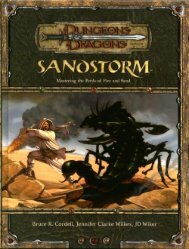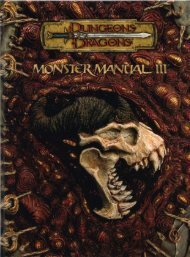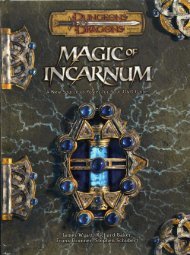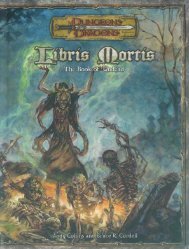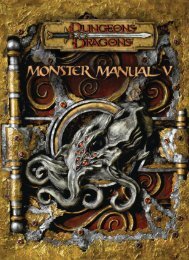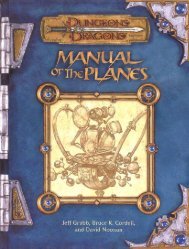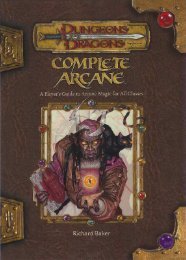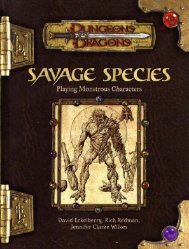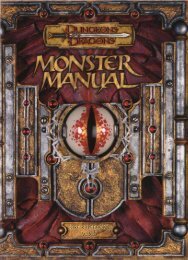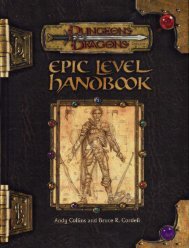CHAPTER 2HALFLINGS44does a halfling go without his music. Someone in the campis almost always playing a tune, and while the caravan is onthe road, singing, whistling, and humming make the tripmore pleasant. Favored instruments among halflings includelutes, lyres, horns, and small drums, as well as more exoticstring and percussion instruments acquired at some pointin their travels. Their best-known compositions are merrytunes that draw listeners into dancing. Among their ownpeople, however, songs <strong>of</strong> the open road and laments for thedeparted that can draw a tear from even the most stoic eyeare equally prized.Though most halflings have a talent for acting, they producevery few plays because such forms <strong>of</strong> entertainmenttend to consume resources while doing little to mend wagons,accrue wealth, or cook dinner. Impromptu skits, however, arequite popular within certain caravans, and less than flatteringrepresentations <strong>of</strong> other races <strong>of</strong>ten add to the frivolity.Among the most important arts in a halfling communityis storytelling. Halflings write down practical information,such as supply lists and transaction records, but they rarelytake the time to record legends or gossip. The oral traditionis stronger in the halfling race than almost any other, andalmost every halfling is an accomplished storyteller. Tellingtales around the campfire has been a tradition among travelinghalflings for as long as anyone can remember, and thefrequent turnover in caravan personnel ensures that thereare always new tales to hear. Though in many cases the talesamount to little more than gossip, word <strong>of</strong> important eventsspreads quickly through the halfling race from caravan tocaravan. Halflings have a deep respect for the oral traditionand thus attach an absolute minimum <strong>of</strong> embellishmentto the original tales. Thus, a tale spread from one end <strong>of</strong> acontinent to the other will be substantially the same as whenit was first told.Several times each year, a number <strong>of</strong> caravans gather ina prearranged location for a storytelling fair. They holdcontests for the best tales and the best renderings, and theypresent cash prizes as well as accolades to the winners. Theseweek-long events also feature craft booths, trained animalacts, feasting, and other forms <strong>of</strong> entertainment. Outsidersare welcome, but few ever attend, put <strong>of</strong>f by the prospect <strong>of</strong>so many thieves and con artists gathered in one place.TECHNOLOGY AND MAGICMost halflings believe that magic is great for driving <strong>of</strong>forcs, entertaining outsiders, and dealing with the occasionalemergency. In the long run, though, technology is <strong>of</strong>tenmore practical and more reproducible. After all, just abouteveryone who makes a wagon wheel goes about it the sameway, and if you studied a wagon wheel long enough, you couldprobably get a good idea <strong>of</strong> how to make one. In contrast, twospellcasters may cast the same spell in entirely different ways,and no one—not even experienced wizards—can figure outhow to reproduce a spell just by seeing its effect.The study <strong>of</strong> magic is a niche activity in halfling communities.Everyone appreciates having a few wizards, sorcerers,and clerics around for emergencies, but their usefulnessis limited in daily life. Magic items, however, are anothermatter entirely. With only minimal instruction, anyonecan use many items <strong>of</strong> power; those that are not needed canbe sold for good prices. Thus, spellcasters who travel withhalfling caravans <strong>of</strong>ten find themselves pressured to eithercreate magic items or find something productive to do withtheir time. Most halflings who pursue such classes also haveother pr<strong>of</strong>essions that are more useful to the community ona day-to-day basis.Halfling spellcasters rarely do research, and they displaya preference for magic <strong>of</strong> the illusion, transmutation, andconjuration schools. Abjurers and diviners are also relativelycommon, while necromancers are practically unknown. Arcanespellcasters usually travel with their clans, but each usuallyhas a wagon <strong>of</strong> his own; most halflings find it prudent to givewizards and sorcerers a wide berth in case <strong>of</strong> accidents.Halfling technology focuses primarily on practical itemsand transportation. Small, portable items are favored so thatthey can easily be carried in wagons or on one’s person. Anyitem that makes daily life easier or can get a caravan out <strong>of</strong>trouble is <strong>of</strong> great interest to a halfling band. Heavy, bulkyitems and equipment are <strong>of</strong> little interest to halflings unlessthey can see a way to sell such items at a handsome pr<strong>of</strong>it.The legend that claims halflings invented horseshoes isprobably false; halflings use goats more <strong>of</strong>ten than horses.Still, that bit <strong>of</strong> lore does speak to the depth <strong>of</strong> the halflings’passion for transportation-related equipment. Goat carts,oxcarts, mine cars, boats, gliders, and all other kinds <strong>of</strong> conveyancesare fascinating to halflings, and they have improvedon most <strong>of</strong> the traditional designs.Animal breeding and training is also an essential part<strong>of</strong> halfling technology because animals power many <strong>of</strong> thehalflings’ conveyances and provide food for the caravan.Halflings have developed breeding to a science and canreliably produce animals with more meat, greater speed, ormore endurance than those raised by most other races.Upgrades in transportation, food preservation, medicinesand tonics, and other technology <strong>of</strong> interest are quickly passedfrom one caravan to another—and to human, dwarf, gnome,and elf communities as well. Even technology that did notoriginate among the halflings spreads quickly once they gethold <strong>of</strong> it.LOVELove is a vital part <strong>of</strong> life, and halflings enjoy it to the fullest.They are devoted to their families; the affection betweenchildren and parents, siblings, spouses, and extended familymembers such as grandparents and cousins is deep andunyielding. So great is the halfling devotion to family thattwo halflings who meet for the first time are likely to spendhours comparing genealogies to figure out how they mightbe related. Should a familial relationship be discovered, nomatter how remote, the two treat one another like long-lostsiblings—at least until one does something perfidiousenough to sour the relationship.
Halflings are as eager to experience romantic love as anyother humanoids. To them, romance is just another greatadventure that may bring weal or woe. Infatuation is commonamong halflings, and since <strong>of</strong>fspring frequently result fromsuch liaisons, lovers typically formalize their relationshipsas soon as possible. Romantic relationships betweenmembers <strong>of</strong> the same caravan or clan are discouraged butnot strictly forbidden.Two levels <strong>of</strong> marriage exist within halfling society.Handfasting is the most common method <strong>of</strong> formalizinga relationship within a halfling community. Only the twolovers and three witnesses <strong>of</strong> their choice need be presentto complete this ritual. The lovers’ hands are usually boundtogether with leather thongs; these are removed, knottedtogether, and presented to the couple at the end <strong>of</strong> theceremony. The lovers speak their own vows, which usuallyconsist <strong>of</strong> a promise to look out for one another’s welfare andremain faithful for as long as love lasts. Handfasted couplesare entitled to their own wagons. If neither party alreadyowns a wagon, one is built by the community at the earliestopportunity and presented to the couple as a gift. Until then,such a couple usually lives in the wagon <strong>of</strong> one or the other’sparents. Handfasted couples are expected to live and worktogether as long as they feel affection for one another.Some handfastings last for decades, and a few last forlife. Often, though, because halflings are intensely curiouscreatures, one partner becomes interested in someone else,or perhaps one wishes to leave for an extended period to goadventuring or join another caravan; and sometimes argumentssimply poison the couple’s love. In such cases, couplescan end their handfasting with a brief ceremony in which theknotted cords they received earlier are untied before threewitnesses and presented to the now-separate individuals.Children <strong>of</strong> such a couple live with whichever parent wantsthem. If both do, a child can choose if he or she is old enoughto speak; younger <strong>of</strong>fspring remain with their mother unlessshe refuses them.The second level <strong>of</strong> formalization is true marriage. Marriagesare much rarer than handfastings and cannot occurbetween members <strong>of</strong> the same clan. Most marriages occurmuch later in life than handfastings, after the lovers havehad a chance to live together as a handfasted couple andbecome certain <strong>of</strong> their love. Some couples never take thisstep at all, content to remain handfasted for their entire lives.A marriage is conducted by a cleric and sparks a week <strong>of</strong>celebration in the entire community. Most married couplesalready have wagons, but those who do not receive themfrom the community, just as handfasted couples do. A newlymarried couple is showered with gifts, and both husbandand wife are instantly accorded the position <strong>of</strong> elders withinthe community.The primary difference between a wedding and a handfastingis that a wedding is for life. The halflings involved maynot dissolve the union, and any attempts to separate or strayresult in the expulsion <strong>of</strong> the guilty party or parties from thecommunity. Thus, marriage occurs only between halflingswho are quite certain <strong>of</strong> their ability to weather the storms <strong>of</strong>a relationship. Though true marriages occasionally go sour,the parties usually learn to resolve their differences and livetogether in (relative) harmony.ReproductionHalflings reach maturity at the age <strong>of</strong> 20, and both genders arecapable <strong>of</strong> reproduction for approximately 40 years thereafter.The gestation period is seven months, a little shorter than that<strong>of</strong> a human. Female halflings rarely give up working, adventuring,or pursuing their usual activities while pregnant, atleast until the last month or so. Halflings with infants orvery young children <strong>of</strong>ten choose to halt their roaming fora few seasons, picking a good camp or a permanent halflingsettlement (or even a human town) until the youngsters area little older. Not all roaming halflings do this, though; somefamilies never leave their caravans.Halflings are adept at avoiding trouble, and halflings withsmall children especially so. Despite the perils <strong>of</strong> disease,weather, monsters, and orc raids, roughly eight in ten childrenreach maturity.HALFLINGS AT WARHalflings rarely declare war on others—after all, winningmight mean becoming tied down with property. In the sameway, having no lands and few goods <strong>of</strong> their own means thathalflings have little need to defend their belongings. No onestarts a war just to take a few dozen wagons, though otherraces may fight long and bloody conflicts over pieces <strong>of</strong> landthat are <strong>of</strong>ten quite small. Having little to lose and no interestin a permanent home frees a halfling to enjoy life in waysthat other races can never appreciate.Halflings are certainly not pacifists, however, and <strong>of</strong>tenfind work as mercenaries in the wars <strong>of</strong> others. Their smallsize and aptitude for sneaking makes them excellent scouts,and their high Dexterity and racial bonus with thrownweapons makes them valuable in units employing rangedweapons. Though halflings have no fear <strong>of</strong> melee combat,they are prudent enough to avoid it when possible. Halflinginfantry units are rare, though halfling cavalry can be surprisinglyeffective due to the halflings’ aptitude with animals andtheir penchant for doing the unexpected on the battlefield.All halflings learn to use slings and javelins well before theyreach maturity. Many also learn how to use short swords andthrowing axes, as well as certain exotic halfling weapons suchas skiprocks and war slings. A halfling’s first line <strong>of</strong> defense isusually a ranged weapon. Should an enemy get close enoughfor melee combat, the longsword or short sword is the mostcommon choice.DEATHThe much-vaunted halfling fearlessness extends even todeath. Most halflings view death as simply the next greatadventure. Though they do not court it, they take no pains toavoid risk, nor do they resort to necromancy or other magicalmeans to stave <strong>of</strong>f death.CHAPTER 2HALFLINGS45
- Page 2: C R E D I T SD E S I G NSKIP WILLIA
- Page 7 and 8: no elf could predict which memory w
- Page 9 and 10: premium. Thus, each individual can
- Page 11 and 12: The elves have raised one form of e
- Page 13 and 14: do spend time away from one another
- Page 15 and 16: espects during this time, and those
- Page 17 and 18: Stores Master: Charged with keeping
- Page 19 and 20: would be the birthright of any full
- Page 21 and 22: of feet above the forest floor. Mos
- Page 23 and 24: Cleric Training: More than any othe
- Page 25 and 26: ELF HISTORYAND FOLKLOREThe elves cl
- Page 27 and 28: along with her son Hionyron, who wa
- Page 29 and 30: and return her to her people.” In
- Page 31 and 32: Table 1-3: Suffixesd% Suffix Meanin
- Page 34: CHAPTER 1ELVES34tri-level tree home
- Page 37 and 38: Illus. by C. Lukacsurious and activ
- Page 39 and 40: the reason for the farmer’s hospi
- Page 41 and 42: Halflings make a visitor feel welco
- Page 43: Halflings are usually pleasant trav
- Page 47: A chief or elder heads each clan, c
- Page 50 and 51: CHAPTER 2HALFLINGS50away from their
- Page 52 and 53: CHAPTER 2HALFLINGS52Illus. by S. Wo
- Page 54 and 55: CHAPTER 2HALFLINGS54to tell how lon
- Page 56 and 57: CHAPTER 2HALFLINGS56the underbrush
- Page 58 and 59: CHAPTER 2HALFLINGSIllus. by T. Baxa
- Page 60 and 61: CHAPTER 2HALFLINGS60Donta muden sit
- Page 63 and 64: and one or more bedrooms. All have
- Page 65 and 66: Illus. by C. Lukacshe cliff-dwellin
- Page 67 and 68: Personality: Raptorans have a reput
- Page 69 and 70: PSYCHOLOGYSome outsiders who have h
- Page 71 and 72: for making a point through a logica
- Page 73 and 74: flock for debate, sometimes invitin
- Page 75 and 76: its eggs. At such times, they toler
- Page 77 and 78: THE RAPTORAN PANTHEONThe typical ra
- Page 79 and 80: Prayers: Prayers to the Stormfather
- Page 81 and 82: “Welcome, friend,” said a human
- Page 83 and 84: year since, and they share the care
- Page 85 and 86: D: Domain spell. Domains: Protectio
- Page 87 and 88: characteristics are summarized in t
- Page 90 and 91: CHAPTER 3RAPTORANS90Authority Figur
- Page 92 and 93: CHAPTER 4OTHERRACES92a humanlike ra
- Page 94 and 95:
CHAPTER 4OTHERRACES94ment, finding
- Page 96 and 97:
CHAPTER 4OTHERRACES96Illus. by S. B
- Page 98 and 99:
Table 4-1: The CentaurHit Base Atta
- Page 100 and 101:
CHAPTER 4OTHERRACES100nomadic gnoll
- Page 102 and 103:
Table 4-2: The GnollBase Fort Ref W
- Page 104 and 105:
CHAPTER 4OTHERRACES104of the humano
- Page 106 and 107:
CHAPTER 4OTHERRACESsneak attack, bu
- Page 108 and 109:
CHAPTER 5PRESTIGECLASSES108Shadowda
- Page 110 and 111:
CHAPTER 5PRESTIGECLASSESIllus. by W
- Page 112 and 113:
CHAPTER 5PRESTIGECLASSES112the foll
- Page 114 and 115:
CHAPTER 5PRESTIGECLASSES114Entry Re
- Page 116 and 117:
CHAPTER 5PRESTIGECLASSESIllus. by J
- Page 118 and 119:
CHAPTER 5PRESTIGECLASSESLUCKSTEALER
- Page 120 and 121:
CHAPTER 5PRESTIGECLASSESIllus. by J
- Page 122 and 123:
CHAPTER 5PRESTIGECLASSESEL 11: Kuly
- Page 124 and 125:
CHAPTER 5PRESTIGECLASSES124spellcas
- Page 126 and 127:
CHAPTER 5PRESTIGECLASSES126save bon
- Page 128 and 129:
CHAPTER 5PRESTIGECLASSESmore than o
- Page 130 and 131:
CHAPTER 5PRESTIGECLASSES130raptoran
- Page 132 and 133:
CHAPTER 5PRESTIGECLASSES132Table 5-
- Page 134 and 135:
CHAPTER 5PRESTIGECLASSESfriendly—
- Page 136 and 137:
CHAPTER 5PRESTIGECLASSESYou no long
- Page 138 and 139:
CHAPTER 5PRESTIGECLASSES138small fe
- Page 140 and 141:
CHAPTER 5PRESTIGECLASSES140ranger.
- Page 142 and 143:
CHAPTER 5PRESTIGECLASSESIllus. by T
- Page 144 and 145:
CHAPTER 5PRESTIGECLASSESEncountersP
- Page 146 and 147:
CHAPTER 6CHARACTEROPTIONS146Conditi
- Page 148 and 149:
CHAPTER 6CHARACTEROPTIONS148If the
- Page 150 and 151:
CHAPTER 6CHARACTEROPTIONSIllus. by
- Page 152 and 153:
CHAPTER 6CHARACTEROPTIONSIllus. by
- Page 154 and 155:
CHAPTER 6CHARACTEROPTIONSIllus. by
- Page 156 and 157:
Table 6-3: Elf Ranger Racial Substi
- Page 158 and 159:
Table 6-5: Halfling Druid Racial Su
- Page 160 and 161:
CHAPTER 6CHARACTEROPTIONS160Table 6
- Page 162 and 163:
Class SkillsRaptoran fighter substi
- Page 164 and 165:
CHAPTER 7EQUIPMENTAND MAGICIllus. b
- Page 166 and 167:
CHAPTER 7EQUIPMENTAND MAGIC166anoth
- Page 168 and 169:
CHAPTER 7EQUIPMENTAND MAGICTable 7-
- Page 170 and 171:
CHAPTER 7EQUIPMENTAND MAGICIllus. b
- Page 172 and 173:
CHAPTER 7EQUIPMENTAND MAGICIllus. b
- Page 174 and 175:
2nd-Level Ranger SpellWoodland Veil
- Page 176 and 177:
WOODLAND VEILIllusion (Glamer)Level
- Page 178 and 179:
CHAPTER 8CAMPAIGNS INTHE WILD178THE
- Page 180 and 181:
CHAPTER 8CAMPAIGNS INTHE WILDIllus.
- Page 182 and 183:
CHAPTER 8CAMPAIGNS INTHE WILD182(lo
- Page 184 and 185:
CHAPTER 8CAMPAIGNS INTHE WILD184Ski
- Page 186 and 187:
CHAPTER 8CAMPAIGNS INTHE WILD186Tab
- Page 188 and 189:
CHAPTER 8CAMPAIGNS INTHE WILDIllus.
- Page 190 and 191:
CHAPTER 8CAMPAIGNS INTHE WILDIllus.
- Page 192:
APPENDIX19261 Guards are needed to
- Page 195 and 196:
2THE CLIFFThe Rifinti dwelling lies
- Page 198 and 199:
supplies for craftwork. Lamps fuele
- Page 200 and 201:
Nae’fidrim: Female owl companion;
- Page 202 and 203:
Creatures: A cleric is always on du
- Page 204 and 205:
cloak of elvenkind, oil of magic we
- Page 206:
aptoran contraries. If visitors can



